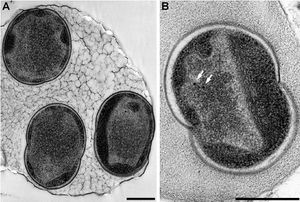Alteromonas SN2
Classification
Domain: Bacteria Phylum: Proteobacteria Class: Gammaproteobacteria Order: Alteromonadales Family: Alteromonadaceae Genus: Alteromonas Species:SN2
Description
The genus Alteromonas was originally defined on 'morphological,physiological,and nutritional' grounds by Baumann et. al. The defining features of that original clade were gram-negative heterotrophic bacteria possessing a polar flagellum and GC content between 42.3 and 48%.(1)
Ecology and Significance
Most Alteromas strains have been isolated from various ocean waters around the world and are generally described as r-strategists (4). Alteromonos SN2 has only been observed and studied in the coastal sands of South Korea. In pure culture and a community environment A. SN2 is capable of degrading aromatic carbon compounds, specifically naphthalene, phenanthrene, anthracene, and pyrene (4). Significantly, it can grow on these substrates without the addition of extra nutrients, making it primly adapted for degrading the aromatic carbon compounds released in large amounts from oil spills. Experiments done by Jin et al. showed that A. SN2 was one of only two organisms expressing genes that can degrade such aromatic compounds in the oil-contaminated sands of South Korea(3). This indicates that these organisms play a major role in the breakdown of such compounds from the environment after oil spills. Experiments by Math et al. have shown that A. SN2 bacteria are capable of growth at the lower temperatures that coastal flats experience through the general.
Genome Structure
References
1. Baumann, L., Baumann, P., Allen, R. D. & Mandel, M. (1972). TAXONOMY OF AEROBIC MARINE EUBACTERIA. Journal of Bacteriology 110, 1972.
2. Ivanova, E. P., Lopez-Perez, M., Zabalos, M., Nguyen, S. H., Webb, H. K., Ryan, J., Lagutin, K., Vyssotski, M., Crawford, R. J. & Rodriguez-Valera, F. (2015). Ecophysiological diversity of a novel member of the genus Alteromonas, and description of Alteromonas mediterranea sp nov. Antonie Van Leeuwenhoek International Journal of General and Molecular Microbiology 107, 2015.
3. Jin, H. M., Jeong, H., Moon, E.-J., Math, R. K., Lee, K., Kim, H.-J., Jeon, C. O., Oh, T. K. & Kim, J. F. (2011). Complete Genome Sequence of the Polycyclic Aromatic Hydrocarbon-Degrading Bacterium Alteromonas sp Strain SN2. Journal of Bacteriology 193, 2011.
4. Jin, H. M., Kim, J. M., Lee, H. J., Madsen, E. L. & Jeon, C. O. (2012). Alteromonas As a Key Agent of Polycyclic Aromatic Hydrocarbon Biodegradation in Crude Oil-Contaminated Coastal Sediment. Environmental Science & Technology 46, 2012.
5. Math, R. K., Jin, H. M., Kim, J. M., Hahn, Y., Park, W., Madsen, E. L. & Jeon, C. O. (2012). Comparative Genomics Reveals Adaptation by Alteromonas sp SN2 to Marine Tidal-Flat Conditions: Cold Tolerance and Aromatic Hydrocarbon Metabolism. Plos One 7, 2012.
6. Ng, H. J., Webb, H. K., Crawford, R. J., Malherbe, F., Butt, H., Knight, R., Mikhailov, V. V. & Ivanova, E. P. (2013). Updating the taxonomic toolbox: classification of Alteromonas spp. using multilocus phylogenetic analysis and MALDI-TOF mass spectrometry. Antonie Van Leeuwenhoek International Journal of General and Molecular Microbiology 103, 2013.
Figures
[1F]
[1] [2F] [2] [3F] [3] [4F] [4] [5F] [Original Figure. Author: Pawan Dhaliwal] [6F]
http://microbewiki.kenyon.edu/index.php/File:Lorenzo.gif
[7F] [5]
Author
Page authored by _____, student of Prof. Katherine Mcmahon at University of Wisconsin - Madison.

